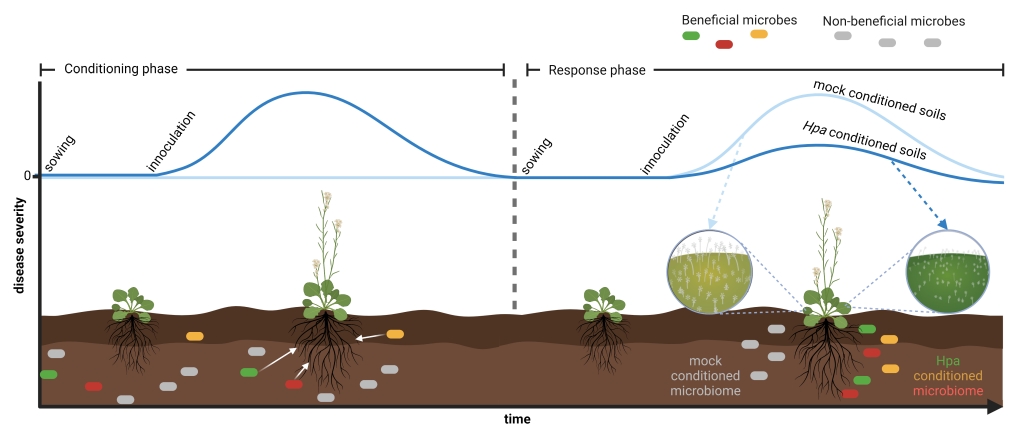Een microbiële erfenis: hoe planten hun nageslacht ‘vaccineren’ tegen ziekteverwekkers
- Jelle Spooren , Universiteit Utrecht
There are 200 billion-trillion stars in the universe, a truly astonishing number. Yet, there are even a billion times more bacteria living in soils on earth! Exploring the great unknown of microbial life in soils is the new frontier for sustainable agriculture. Plant roots are embedded in these soils and closely interact with the microbes present. Plants that are attacked by pathogenic microbes can attract beneficial microbes that stimulate the plant immune system. These beneficial microbes are nurtured by the plant and can therefore build-up in the soil. As a result, soils can become disease suppressive, meaning that subsequent plant populations experience improved health. Thus, plants vaccinate themselves and their descendants via the soil to retain health.
In our research, we study the interaction between plants and beneficial microbes in the context of disease suppressive soil. We integrate the fields of biochemistry and plant- microbial- and molecular biology, to identify beneficial bacteria that are attracted by plants under siege, and to understand how plants communicate with these microbes to create a disease suppressive soil. To this end, we designed an experimental system in which we grow consecutive plant populations in the same soil challenged by an above ground pathogen. As a result, the soil becomes disease suppressive meaning that plants are better protected against this pathogen when growing in a soil that has been previously populated by diseased plants.
We demonstrated that hormonal plant defense responses are stimulated by soil microbes that become more abundant around the roots. Mutant plants that are unable to produce specific metabolites in the roots lack this microbial shift and consequently the ability to create a disease suppressive soil. This shows that the plant is actively communicating with beneficial microbes in the soil to vaccinate itself and its descendants against disease.
Also the leaves of plants infected by the pathogen are inhabited by a conserved group of bacteria. We demonstrated that diseased plants recruit these bacteria from soil, from where they accumulate on roots and leaves to help the plant in combatting infection. These bacteria spread from plant to plant alongside the pathogen. In this way, they become a nested mediator between the plant and the pathogen to secure plant health.
By understanding the ways in which plants communicate with soil microbes we can breed plants that are optimized for exploiting the full beneficial potential of these interactions. Moreover, by identifying key microbes that stimulate the plant immune system, we can culture and deploy them together with seeds in agricultural soils where they can reduce crop loss. In this way, we can prevent major crop losses that threaten food security world-wide.

Dit schema laat zien hoe de microbiële erfenis werkt (infographic: Tilda Tarrant, Jelle Spooren, UU).
Publicaties:
Bakker, P. A., Pieterse, C. M., de Jonge, R., & Berendsen, R. L. (2018). The soil-borne legacy. Cell, 172(6), 1178-1180.
Berendsen, R. L., Vismans, G., Yu, K., Song, Y., de Jonge, R., Burgman, W. P., ... & Pieterse, C. M. (2018). Disease-induced assemblage of a plant-beneficial bacterial consortium. The ISME journal, 12(6), 1496-1507.
Vismans, G., Spooren, J., Pieterse, C. M., Bakker, P. A., & Berendsen, R. L. (2021). Soil-Borne Legacies of Disease in Arabidopsisthaliana. In The Plant Microbiome (pp. 209-218). Humana, New York, NY.
Vismans, G., van Bentum, S., Spooren, J., Song, Y., Goossens, P., Valls, J., ... & Berendsen, R. L. (2022). Coumarin biosynthesis genes are required after foliar pathogen infection for the creation of a microbial soil-borne legacy that primes plants for SA-dependent defenses. Scientific Reports, 12(1), 1-12.
Goossens, P. & Spooren,J. Baremans, K.C.M., Lapin,D. Echobardo, Pieterse, C.M.J. Van den Ackerveken, G., Berendsen, R.L. (submitted 2023). Conserved disease-associated resistobiomes form a plant protective soil-borne legacy.
Referenties
« Terug naar overzicht